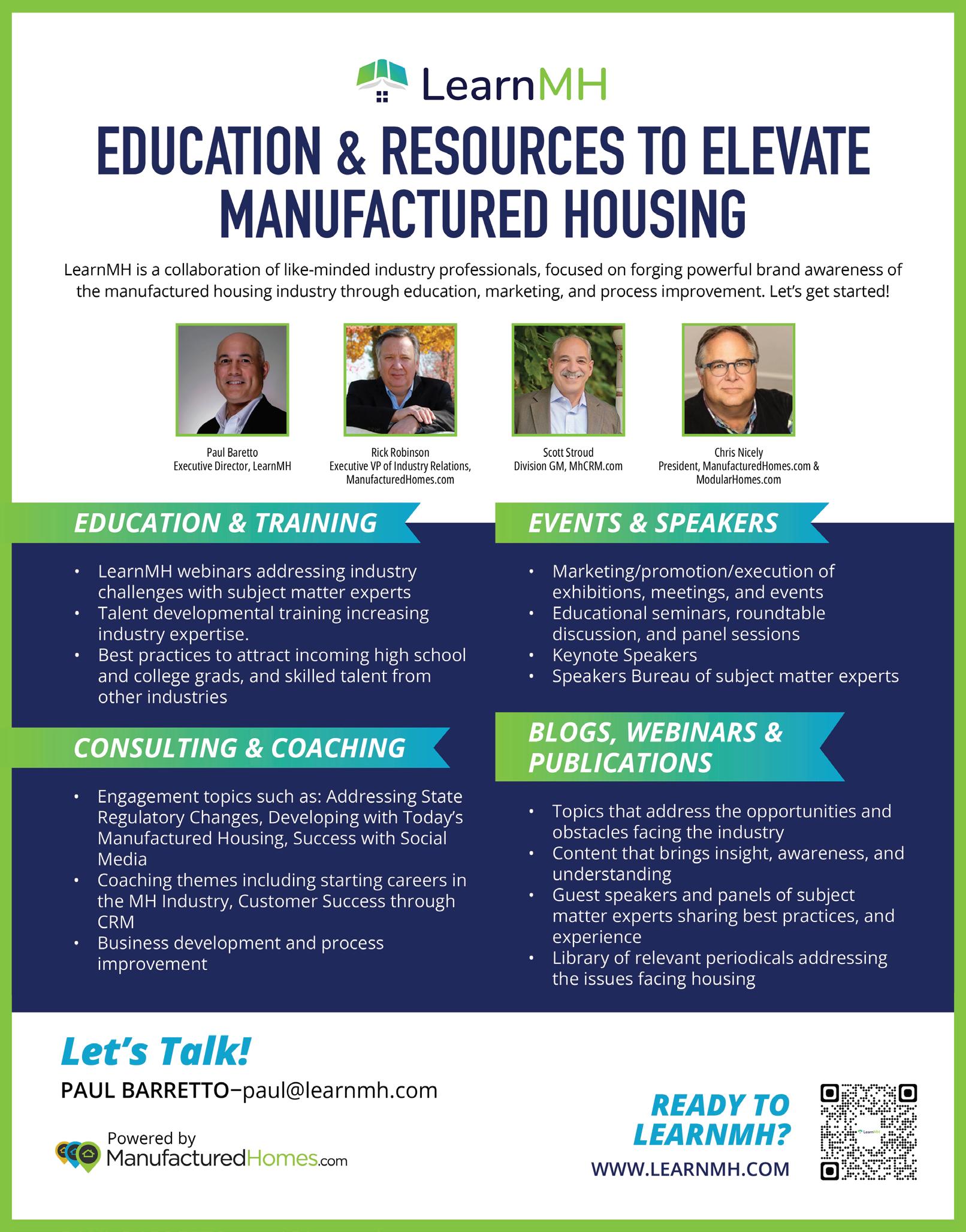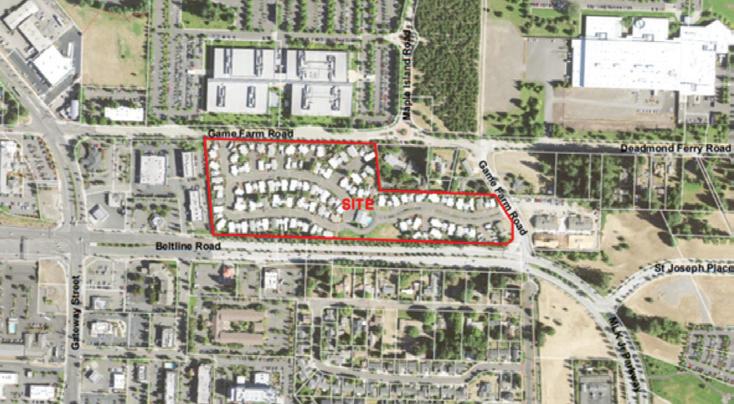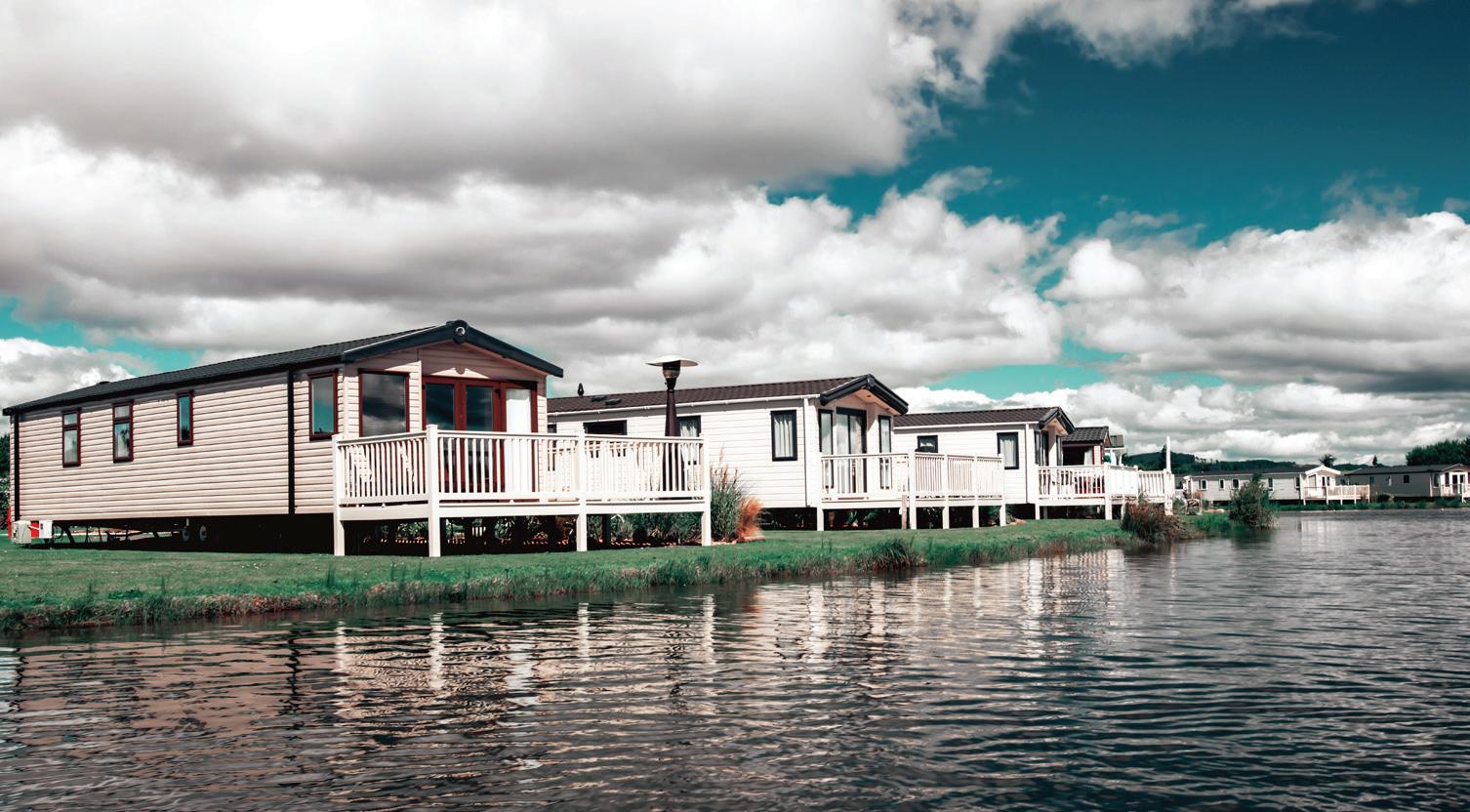MHR
MANUFACTURED HOUSING REVIEW
News and educational articles to help you run your business in the manufactured home industry.
IN THIS ISSUE:
10 Tips to Grow Your Market
Whipping Inflation
The Actual Facts About Rent Control
Five Reasons Why Mobile Home Parks in the United States are Disappearing and more!


Sponsored by:

2022 | Quarter 2
Table of Contents The Actual Facts About Rent Control 3 By Frank Rolfe First Trust - May ISM Manufacturing Index 6 By Brian S. Wesbury, Robert Stein, CFA, Strider Elass, Bryce Gill – Economist New Organization to Advance Women in Manufactured Housing 7 By Patrick Revere Importance of Rental Approval Standards 9 By Wisconsin Housing Alliance Texas’ Manufactured-Housing Industry Sees Price Improvements, But Long-Run Challenges Persist 10 As Your Values Rise, So Does Your Risk of Loss 11 By Kurt D. Kelley, J.D. The “Mobile Home Park Re-Development Bill” Gets Shot Down By The Governor Of Colorado 13 By Benjamin Ivry Housing Manufacturers Expect Rising Costs, Higher Interest Rates to Level Playing Field with Conventional Builders 15 By David Jones and Bryan Pope Five Reasons Why Mobile Home Parks in the United States are Disappearing 17 By Andrew Keel HUD Code Homes and Missing Data Plates or HUD Labels 19 By Wisconsin Housing Alliance The Predictable End of Cheap Home Mortgages Yields Good News for Park Owners 21 By Frank Rolfe Doe Resorts to Deception and Misdirection to Advance Its Flawed Energy Rule for Manufactured Housing 23 By Mark Weiss Whipping Inflation 25 By Brian Wesbury and Robert Stein 10 Tips to Grow Your Market 28 By Chris Nicely
The Actual Facts About Rent Control

The Wall Street Journal recently released an article touting a grassroots movement for rent control. It cites that U.S. rents are up 18% on average in some markets as the catalyst to a new world order in which rents are set by the state government. So how realistic is the concept of rent control in the markets that have not embraced it over the past 100 years? There’s a lot more math to this issue than what the Wall Street Journal released to readers.
Let’s get down to the actual facts as can be found on a simple search on Wikipedia.
Here are the current stats in the United States regarding rent control, straight from Wikipedia:
Oregon is the only state with a statewide rent control law, enacted in 2019. Four other states—California, New York, New Jersey, and Maryland—have localities in which some form of residential rent control is in effect. The District of Columbia also has rent control for some rental units; publicly owned or assisted properties, properties built in 1978 or later, and properties held by an owner with fewer than five rental units are exempt from D.C.’s rent-control law.
Thirty-seven states either prohibit or preempt rent control, while eight states allow their cities to enact rent control but have no cities that have implemented it.
As of 2019, about 182 U.S. municipalities have rent control: 99 in New Jersey, 63 in New York, 18 in California, one in Maryland, and Washington, D.C. The five most populous cities with rent control are New York City; Los Angeles; San Francisco; Oakland; and Washington, D.C. The sole Maryland municipality with rent control is Takoma Park.
By Frank Rolfe
Wow, that’s not in any way like the tone of the article, which made it sound like rent control was just around the corner nationwide.
Now let’s dissect those facts
There are 50 states in the U.S. Of those 50 states, rent control in any form is illegal in 37 of them. So that means that even a discussion of rent control is unlikely in 74% of states. To change the laws of a state would require a massive referendum, followed by massive litigation – and it has to make it to the ballot box first which requires enough votes in the state legislature. So that means that any discussion of rent control in these 37 states is basically a waste of time.
Then you have 8 states that allow rent control on a city-by-city basis, yet no city in that state has ever enacted rent control. Those 8 states are Montana, Wyoming, Nebraska, Nevada, Pennsylvania, West Virginia, and Virginia. And then you have rent control already enacted in just one state, Oregon, and in some cities in California, New Jersey, Maryland and New York.
Now let’s attach some common-sense metrics
Let’s forget the states that do not allow rent control as a point of law, and then write off those states that already have rent control in one city or more, as well as the state of Oregon (the only state in the U.S. with state-wide rent control laws). So really what’s up for grabs -- if there was to ever be any additional rent control in the U.S. -- emanates from those 8 states where rent control is actually legal but has never been adopted. Let’s look at each one independently:
• Wyoming. This is one of the strongest “red” states, with the last time they elected a democratic president being in 1964. The odds of Montana passing any form of rent control is about as likely as being able to jump from San Francisco to Hawaii.
• Montana. This state is just as staunchly red as Wyoming. No chance it would ever allow rent control, and everyone knows this.
• Nebraska. This is a solid red state, with only LBJ in 1964 as a democratic victory since inception.
• Nevada. This is a “swing” state that is almost evenly divided between red and blue votes.
• Pennsylvania. Another “battleground” state that is very evenly divided between red and blue.
- 3 -
The Actual Facts About Rent Control Cont.
• West Virginia. This is a predictably red state with the only thing blue being Joe Manchin (who is the person who blocked the Biden agenda).
• Vermont. It’s hard to find a state that is more left-leaning than Vermont.
• Virginia. This is a state that can politically go either way, but still has a majority of red voters.

So, the simple analysis of these eight states is that there are only four that might ever adopt rent control: Nevada, Pennsylvania and Virginia.

Putting it all together
Despite media groups trying to appeal to their woke reader base, the simple fact is that rent control is not pending in any form or fashion in 41 states (which represents 82% of America), already exists in 5 states (10%) and might have a chance in maybe 4 more (8%). Therefore, the correct title for this Wall Street Journal article should have been “Rent-Control Measures Are Not Back Except in Maybe Three States Which Are Only 50% Democrat and Probably Won’t Vote to Ever Enact Them in Any Reader’s Lifetime” or better yet “Did You Know that State-Wide Rent Control Only Exists in Oregon After 100 Years of Availability – And That Oregon Currently Allows 15% Annual Increases So It’s of No Value to Anyone?”
Conclusion
The future of rent control is just simply about applying math and probability. Articles like this one by the Wall Street Journal – which used to be a fair and balanced publication – are simply designed to gain favor with left-leaning readers at the expense of those who have not taken the time to review the actual stats supporting the topic. State laws and political orientations make rent control a non-starter of biblical proportions. At this stage you have about as much chance of passing “defund the police” initiatives (which are also still getting press with some media groups). Perhaps they could combine them into one bill and give that a shot?
Frank Rolfe has been a manufactured home community owner for over two decades, and currently ranks as part of the 5th largest community owner in the United States, with more than 23,000 lots in 28 states in the Great Plains and Midwest. His books and courses on community acquisitions and management are the top-selling ones in the industry. To learn more about Frank’s views on the manufactured home community industry visit www.MobileHomeUniversity.com
- 4 -
THE MANUFACTURED COMMUNITY OWNERS’ ASSOCIATION OF AMERICA

Finally Bringing Fight to the Manufactured Home Community Sector of the Industry
So, what can you do to support this effort? It will cost money to enact this agenda –not much but a little. We have priced our memberships at $120 per year. We are hoping to initially get 100 mobile home park owners to join, which will generate around $1,000 per month in revenue, all of which will be used to promote our media agenda. As our membership grows, we will simply ramp up our media blitz efforts.
Park Owner Name:
Corporate Name:

Email:
Facebook:
Website:
Phone:
Comments:
Can we use your comments in our articles? YesNo
Please send your support via PayPal to Staff@Manufacturedhousingreview.com
Support MCOAA
May ISM Manufacturing Index
May ISM Manufacturing Index
Brian S. Wesbury – Chief Economist
Robert Stein, CFA – Dep. Chief Economist
Strider Elass – Senior Economist Bryce Gill – Economist
The ISM Manufacturing Index increased to 56.1 in May, beating the consensus expected 54.5. (Levels higher than 50 signal expansion; levels below 50 signal contraction.)
The ISM Manufacturing Index increased to 56.1 in May, beating the consensus expected 54.5. (Levels higher than 50 signal expansion; levels below 50 signal contraction.)


The major measures of activity were mixed in May, but nearly all stand above 50, signaling growth. The production index rose to 54.2 from 53.6 in May, while the new orders index increased to 55.1 from 53.5. The employment index fell to 49.6 from 50.9, and the supplier deliveries index fell to 65.7 from 67.2 in May.
The major measures of activity were mixed in May, but nearly all stand above 50, signaling growth. The production index rose to 54.2 from 53.6 in May, while the new orders index increased to 55.1 from 53.5. The employment index fell to 49.6 from 50.9, and the supplier deliveries index fell to 65.7 from 67.2 in May.
The prices paid index declined to 82.2 in May from 84.6 in May.
The prices paid index declined to 82.2 in May from 84.6 in May.

Implications: The manufacturing sector continued to expand in May, and at a slightly faster pace, with fifteen of eighteen industries reporting growth. The best news in today’s report was that the two most forward-looking indices, new orders and production, posted gains after two months in a row of declines. Moreover, both indices are above 50, signaling growth. Respondent comments in May highlighted strong ongoing demand from customers while also reiterating supply-chain problems related to shortages of key inputs and transportation services. The ongoing COVID-19 shutdowns in China were explicitly mentioned in the comments as well, with gridlock at the ports exacerbating the ongoing issues already mentioned. These issues have all come together to keep manufacturing activity from rising quickly enough to meet an explosion of demand. The good news is that progress is being made, with the supplier deliveries index falling in May and sitting well below its recent high one year ago. However, delays are far from over, with fifteen of eighteen industries reporting waiting longer for inputs. This, in turn, has resulted in long lead times for the clients of US factories, who continued to see their inventories shrink in May. Meanwhile, the employment index fell (barely) into contraction territory in May, declining to 49.6 from 50.9 in April. It looks like the manufacturing sector, which is one of the worst-hit sectors in the ongoing labor shortage, is contending with a tight labor market just like everyone else. Data out this morning shows that job openings in the manufacturing sector are at a record high and roughly 150% of where they were pre-pandemic. Finally, the highest reading of any index in May continued to come from the prices index, which fell slightly to 82.2 but remains very elevated versus history. It looks like the invasion of Ukraine, and now the shutdowns in China, have temporarily boosted inflationary pressure over and above pre-existing inflation related to an overly expansionary Federal Reserve. Inflation this year will ultimately moderate from the pace we saw last year, but not just yet. In other news this morning, construction spending increased 0.2% in April, with large increases in home building and manufacturing offsetting declines in power and transportation projects. In other recent news, home prices continued to surge in March. The national Case-Shiller index increased 2.6% in March and is up 20.6% from a year ago, both record increases. The price gains in the past twelve months were led by Tampa, Phoenix, and Miami, with the slowest price gains in Minneapolis, Washington, DC, and Chicago. The FHFA index, which measures prices for homes financed with conforming mortgages, increased 1.5% in March and is up 19.0% from a year ago. Look for further national price gains in the remaining months of 2022, but at a much slower average pace. Prior price gains plus higher mortgage rates will be significant headwinds for further price gains in the next few years
Implications: The manufacturing sector continued to expand in May, and at a slightly faster pace, with fifteen of eighteen industries reporting growth. The best news in today’s report was that the two most forward-looking indices, new orders and production, posted gains after two months in a row of declines. Moreover, both indices are above 50, signaling growth. Respondent comments in May highlighted strong ongoing demand from customers while also reiterating supply-chain problems related to shortages of key inputs and transportation services. The ongoing COVID-19 shutdowns in China were explicitly mentioned in the comments as well, with gridlock at the ports exacerbating the ongoing issues already mentioned. These issues have all come together to keep manufacturing activity from rising quickly enough to meet an explosion of demand. The good news is that progress is being made, with the supplier deliveries index falling in May and sitting well below its recent high one year ago. However, delays are far from over, with fifteen of eighteen industries reporting waiting longer for inputs. This, in turn, has resulted in long lead times for the clients of US factories, who continued to see their inventories shrink in May. Meanwhile, the employment index fell (barely) into contraction territory in May, declining to 49.6 from 50.9 in April. It looks like the manufacturing sector, which is one of the worst-hit sectors in the ongoing labor shortage, is contending with a tight labor market just like everyone else. Data out this morning shows that job openings in the manufacturing sector are at a record high and roughly 150% of where they were pre-pandemic. Finally, the highest reading of any index in May continued to come from the prices index, which fell slightly to 82.2 but remains very elevated versus history. It looks like the invasion of Ukraine, and now the shutdowns in China, have temporarily boosted inflationary pressure over and above pre-existing inflation related to an overly expansionary Federal Reserve. Inflation this year will ultimately moderate from the pace we saw last year, but not just yet. In other news this morning, construction spending increased 0.2% in April, with large increases in home building and manufacturing offsetting declines in power and transportation projects. In other recent news, home prices continued to surge in March. The national Case-Shiller index increased 2.6% in March and is up 20.6% from a year ago, both record increases. The price gains in the past twelve months were led by Tampa, Phoenix, and Miami, with the slowest price gains in Minneapolis, Washington, DC, and Chicago. The FHFA index, which measures prices for homes financed with conforming mortgages, increased 1.5% in March and is up 19.0% from a year ago. Look for further national price gains in the remaining months of 2022, but at a much slower average pace. Prior price gains plus higher mortgage rates will be significant headwinds for further price gains in the next few years. Institute for Supply Management Index
- 6June 1, 2022 • 630.517.7756 • www.ftportfolios.com
May-22Apr-22Mar-223-month 6-month Year-ago Seasonally Adjusted Unless Noted: 50+ = Econ Growth moving avgmoving avglevel Business Barometer 56.1 55.457.156.257.361.6 New Orders 55.1 53.553.854.157.266.3 Production 54.2 53.654.554.156.360.4 Inventories 55.9 51.655.554.354.151.1 Employment 49.6 50.956.352.353.051.4 Supplier Deliveries 65.7 67.265.466.165.778.8 Order Backlog (NSA) 58.7 56.060.058.259.870.6 Prices Paid (NSA) 82.2 84.687.184.679.088.0 New Export Orders 52.9 52.753.252.953.955.4
This report was prepared by First Trust Advisors L. P., and reflects the current opinion of the authors. It is based upon sour ces and data believed to be accurate and reliable. Op inions and forward looking statements expressed are subject to change without notice. This information does not constitute a solicitation or an offer to buy or sell any security. June 1, 2022 • 630.517.7756 • www.ftportfolios.com
Source: National Association of Purchasing Management
Brian S. Wesbury – Chief Economist
Robert Stein, CFA – Dep. Chief Economist
Strider Elass – Senior Economist
Bryce Gill – Economist
Institute for Supply Management Index May-22Apr-22Mar-223-month 6-month Year-ago Seasonally Adjusted Unless Noted: 50+ = Econ Growth moving avgmoving avglevel Business Barometer 56.1 55.457.156.257.361.6 New Orders 55.1 53.553.854.157.266.3 Production 54.2 53.654.554.156.360.4 Inventories 55.9 51.655.554.354.151.1 Employment 49.6 50.956.352.353.051.4 Supplier Deliveries 65.7 67.265.466.165.778.8 Order Backlog (NSA) 58.7 56.060.058.259.870.6 Prices Paid (NSA) 82.2 84.687.184.679.088.0 New Export Orders 52.9 52.753.252.953.955.4
This
Source: National Association of Purchasing Management
report was prepared by First Trust Advisors L. P., and reflects the current opinion of the authors. It is based upon sour ces and data believed to be accurate and reliable. Op inions and forward looking statements expressed are subject to change without notice. This information does not constitute a solicitation or an offer to buy or sell any security.
New Organization to Advance Women in Manufactured Housing
From left, Maria Horton and Justine Natalie are among the industry professionals organizing Women Advancing Manufactured Housing. A new organization formed by manufactured housing professionals is recruiting members and building partnerships to organize on a single platform for an important voice in advancing the industry.

Women Advancing Manufactured Housing is the result of years of casual conversation about organizing a coalition for women in the industry and came to fruition during a roundtable discussion among Justine Natalie from Dynamic MH Solutions, Maria Horton from Newport Pacific, Sherrie Clevenger from CoreLogic, Maryuri Barberan from Pentagon Properties, and Kim Shultz-Rainford from Affordable Casa Group at the recent SECO Conference.
The five primary organizers comprise the executive committee for the new group. While the group focuses on the support and advancement of women for the industry, the organization is open to any manufactured housing professional who wants to be involved.

“WAMH is a movement that has been discussed for many years,” Horton said. “The group that has come together to see it come to life has a combined 150 years of experience in all aspects of the industry, and we remain excited to honor, recognize and learn from all industry professionals who want to join.”
Horton said the organization will partner with an existing nonprofit while it continues to organize its legal and operating structure. WAMH’s mission is to support women in the industry, improve the perception of manufactured housing, and collaborate and expand each member’s knowledge and network.
By Patrick Revere
Organizers for WAMH have been meeting weekly since October and are planning quarterly member meetings with subject matter experts, including at in-person events as the organization grows. WAMH already has a modest number of supporters who have committed to membership as well as providing startup funding.
WAMH Key Goals
1. To provide a supportive network to increase the presence and voice of women in the manufactured housing industry.
2. Consistently strive to improve the perception of manufactured housing.
3. To create a collaborative effort for general industry answers and to share and expand the knowledge of each and every member of WAMH.
“Although it’s been a relatively short time since WAMH was formed, this phenomenal group of women has already contributed fantastic strategic ideas to drive positive momentum within manufactured housing,” WAMH co-founder Justine Natalie said. “ I am honored to be on the executive committee and to partner with industry professionals as we work toward our WAMH mission statement. We are looking forward to spreading the word of WAMH and are excited about what we are striving to bring to the industry in terms of knowledge, support, and mentorship.”
- 7 -
Patrick Revere is associate vice president of MHVillage and publisher for the MHInsider magazine and blog for industry professionals. His background is in print news, language, and communication.

Importance of Rental Approval Standards
Good rental approval standards help to attract and keep good tenants and discourages prospective tenants with a history of irresponsible behavior from applying. All landlords should have an established screening procedure.
Screening usually involves checking an applicant’s financial ability to pay rent and checking the applicant’s rental history. Many landlords believe that fair housing laws prevent them from screening perspective tenants. This is not true. A landlord can fully comply with fair housing laws and use effective screening methods that help select responsible tenants.

Start with creating screening criteria that you will apply consistently to each applicant. Having consistent screening criteria makes the screening process easier and keeps landlords from inadvertently discriminating against an applicant. Below are samples to get you started.
• Income Policy - The applicant’s rent plus home payment shall not exceed 30% of applicant’s total gross household income.
• Rental History – Minimum of ____ years of rental history required. In the absence of sufficient rental history, a co-signer will be required. (Home mortgage history is acceptable, as well.)
• No Evictions – No person will be approved who has a court ordered eviction within the past ____ years.
• Credit History – A credit report is required which shall reflect a habit of prompt payment of debts and no
By Wisconsin Housing Alliance
unsatisfied judgments. Landlord reserves the right to require a co-signer if negative items are in the credit report. (Good idea to set a credit score threshold.)
• Verification of Employment – The applicant shall have verifiable income and/or employment. The applicant shall have a minimum of _________ (months or years) of continuous income at the time of application. If the applicant’s income is based on retirement income, disability income, or any other lawful source of income, the applicant shall provide proof of income.
• Judgment – Judgment for a financial delinquency to a landlord or mortgage company is grounds for denial of the applicant.
• Criminal Background – No person who within the last ___ years has been convicted of: violence to persons, destruction of property, and/or a drug related crime (the manufacture or distribution of a controlled substance).
• Co-Signers – Co-signers shall meet the same criteria as applicants regarding credit references and a record of timely payment of debts. The co-signer is only agreeing to guarantee payments for the term of the rental agreement unless specified in the Co-signer Agreement. The landlord is not obligated to offer the applicant the co-signer option.
These are just a start. Join the Wisconsin Housing Alliance and check out the Model Rental Approval Standards on the Forms & Tools page under Community Owner Resources. Having rental approval standards posted on your website or to hand out with an application will help applicants know what is needed to rent in your community and possibly even have less applications you need to deny.
Wisconsin Housing Alliance 258 Corporate Drive, Suite 200C, Madison, WI 53714 phone: 608-255-3131 / fax: 608-255-5595

- 9 -
Texas’ Manufactured-Housing Industry Sees Price Improvements, But Long-Run Challenges Persist
COLLEGE STATION, TX
Price pressure for raw materials showed signs of easing in April, according to the latest Texas Manufactured Housing Survey (TMHS). While prices continued to increase, the raw-materials index marked its largest monthly deceleration since July 2020, and manufacturers believe that trend may continue.
“The slowdown in price appreciation for raw materials is a welcomed sign,” said Dr. Harold Hunt, research economist at the Texas Real Estate Research Center (TRERC) at Texas A&M University, “but the Bureau of Labor Statistics’ Producer Price Index (PPI) continues to trend above double-digit growth. The PPI is released with a one-month lag, so we’ll have to wait until next month to see if the rest of the economy experienced price relief during April.”
The root of the manufactured housing’s price improvement is unclear, and supply-chain disruptions persisted for the eighth straight month. Production lines, however, continued to pump out new homes and chip away at backlogs.
While demand remained robust, the combination of supplyside challenges, growing uncertainty, and impending regulatory burdens weighed on the industry’s outlook and overall optimism.
“The Department of Energy’s consideration of updating efficiency standards and its preference for the most stringent changes tempered manufacturers’ expectations,” said Rob Ripperda, vice president of operations for the Texas Manufactured Housing Association.

The TMHS regulatory-burden index reflected these concerns with a positive reading in 13 of the past 14 months.
“Other headwinds include higher mortgage interest rates for both real and personal property as well as a hit to housing manufacturers’ stock prices,” said Ripperda.


The industry anticipates a slowdown in capital expenditures and hiring activity through the summer to adjust to these obstacles.
While Texas’ manufactured-housing outlook remains positive, the health and resilience of the broader economy remains a critical factor moving forward.
This story was initially published by Corridor News.
- 10 -
As Your Values Rise, So Does Your Risk of Loss

The headline is that home values are rising. New home, used home, and home repair costs are up. Owners of buildings, homes, and other property have ridden this wave of high inflation and smiled as their net worth rose. Commercial property values have significantly increased. Property owners are patting themselves on the back for being such smart investors.
But as asset values rise, so does the risk of loss. Five years ago, many investors were comfortable insuring a 1995 three bedroom, two bath single section manufactured home for as little as $15,000.

Today, if you can transport and install a manufactured home for less than $10,000, that’s a reasonable deal. The cost of buying a replacement home is on top of that. The cost of a new single section roof is $7,000 or more. A multi section roof will cost $10,000 or more. A new base model three bedroom, two bath single section home delivered and installed to your manufactured home community will cost $65,000 or more.

Repair costs have risen as much or more as new home costs. Base repairs that were billed at $15 an hour, three years ago, are now contracted at $30 an hour. Repairs that require skilled labor have increased in cost from $30 an hour to $50 an hour. Replacement parts are up 30% in the last few years, presuming you can find them at all.
As investors know, there is the time value of money as well. There’s a monetary cost associated with waiting three months to have a repair done without which a rental home isn’t

 By Kurt D Kelley, J D
By Kurt D Kelley, J D
habitable. If you want to order one or more homes from a factory, twelve months is a typical delivery time today.
Don’t wait until the next catastrophe to revalue your property for insurance purposes. Many investors tend to value repair and replacement costs based on their historical experiences. It’s painful to realize you insured a wind destroyed home for $20,000 and it’s going to cost you $40,000 to replace it with a similar one. It’s financially crippling to realize you insured 30 wind destroyed home for $600,000 and it’s going to cost you $1,200,000 to replace them with similar used ones if you can find them at all, or $1,800,000 to replace them with like new homes in 12 to 18 months. Invest the time to visit with your insurance agent about your insured property limits.
- 11 -
Kurt is an investment property owner, a lawyer and the President of Mobile Insurance, an insurance agency specializing in insuring the manufactured home industry.
Kurt@MobileAgency.com www.mobileagency.com
and mother nature.
• Offers superior protection from high winds, frost heaving, and hail.
• Covered by a Limited 1-year No Hole Warranty, extended to 5 years upon registration.
• Panel colors include White, Dove, and Clay.
• An insulated panel is also available...

XTERIOR Elite.

www.stylecrestinc.com/titan-xterior | 800.945.4440 Foundation Covers | HVAC | Doors & Windows | Steps & Rails | Setup Materials | Vinyl Siding | Plumbing | Electrical Designed specifically for Manufactured Homes.
to withstand the demands of everyday life. Our
by
care
playful children,
Titan XTERIOR Prime is a foundation cover built
reinforced panel design resists damage caused
lawn
accidents,
Engineered for Strength. Designed for Beauty! prime Xterior Titan
Titan
The “Mobile Home Park Re-Development Bill” Gets Shot Down By The Governor Of Colorado

Yet It Should Never Have Made It That Far
The fate of Colorado mobile home parks was spared by a Democratic Governor’s threatened veto in the last few weeks. At issue was a bunch of crazy folks in the state congress wanting to enact rent control only on mobile home parks and no other form of housing. Whether or not this is even legal, the unintended consequences would have simply been, that each and every mobile home park owner, over the years, would have sold their land for a more productive – and unrestricted – use. That’s why I have dubbed this proposal the “Mobile Home Park Redevelopment Act” so that it is at least correctly named. Fortunately Governor Polis, who is a successful businessman, had the good sense to see the handwriting on the wall and strike this mania down. But what’s really disturbing is that such a measure should have gone so far as to nearly reach his desk.
It is continually disheartening to see all the unfair media attacks on the manufactured housing industry that go unanswered. Esther Sullivan – the associate professor in Boulder that launched, by her own admission, roughly 40 media attacks on the industry including John Oliver – and her contemporaries continue to land blow after blow without so much as a single punch from our industry. As a result, these forces have become so bold as to propose nearly anything imaginable without any fear of retribution. Yet the concept of a rent control on only one form of housing is so ludicrous that it begs the question, “have we become the laughingstock of all real estate sectors?”
The Colorado Manufactured Housing Association did a spectacular job in defeating this bill, and the proof’s in the pudding. My hat is clearly off to them. But there’s no reason
By Benjamin Ivry
they should have been put in that position, and it is the fault of every mobile home park owner who turns the other cheek and refuses to put up a fight when woke ideologies gain traction with good-natured legislators who are afraid to stand up to them.
Whether or not the far left wants to accept it, America still is a free country where owners of property can do what they like with it. And rent control is a quick and easy way to help owners make the decision to redevelop into a different use. Here’s how it works:
• • Mobile home parks are not a very high use of land. The value per square foot for usage as apartments, office, retail – even modern warehouse – is far higher. Many mobile home parks today are only functioning in that capacity because mom and pop owners don’t want to mess with removing residents or going through zoning. But it’s not their decision to make, it’s the next owner in the progression.
• The next generation of owners are not going to operate mobile home parks that are in poor condition, yet they are also not going to bring old parks back to life – and expend a fortune in capital to do so – without the ability to raise rents to market levels.
• Meanwhile, most mobile home parks have great locations on major roads due to the simple fact that they were built a half-century ago (circa 1950 to 1970) and cities have built up around them. And they come in just the sizes that most developers adore (5 to 10 acres).
• Apartments alone rent for an average of around $1,600 per month and you can stack them two to four stories high in the same space as a coupe mobile home lots renting for around $300 per month. It’s not rocket science.
• There are around 44,000 mobile home parks in the U.S. and the majority are still owned by moms and pops and need major investment to be brought back to life. So it’s not like this decision of “park vs. other use” is a fringe topic in the U.S. – it’s the bread and butter decision that most of these properties will be making in the next few years.
• Add these factors together you get “goodbye mobile home park and hello new use”.
The same people who pushed the narrative of “The Mobile Home Park Re-development Act” were also busy at work trying to build a feature length movie to promote their cause, called
- 13 -
The “Mobile Home Park Re-Development Bill” Gets Shot Down By The Governor Of


earns more money. And low rents will guarantee that the residents always lose that auction.


My hat’s off to Governor Jared Polis for taking the correct action to save the homes of Colorado’s mobile home park population. His action literally spared hundreds of Denver Meadows-styled park re-developments from happening. He saw through the idiocy of the woke agenda on this issue. But can we please, as an industry, stand up to these forces and spread the word that – whether the far-left likes it or not – any rent control initiative are simply a “Mobile Home Park Redevelopment Act”?
“A Decent Home”. While I have only watched the preview on YouTube, (and it will certainly not be making it to a theater near you but only woke film festivals that cost $100 to enter), I did some research on the film, and it intends to publicly shame a mobile home park owner named Shawn Lustigman who sold his park, Denver Meadows, for around $50 million (I assume that’s the one) to a developer to scrape it and put in a new use. This has me completely confused. How would rent control on mobile home parks not create more Shawn Lustigman and Denver Meadows situations rather than fewer? Somebody will have to explain this to me because I’m lost.
Apparently the woke forces want to skip over the actual fundamentals of business and property ownership. They wouldn’t want to let reality get in the way of their beautiful message. I guess at the heart of “The Mobile Home Park Redevelopment Act” is just faulty theory, namely that rent control will force mobile home park owners to sell to the residents – the endless tired mantra promoted by ROC USA (Resident Owned Communities) and others. Well, that’s not going to happen unless the residents can outbid Home Depot or the apartment developer or whoever else has a better plan that
One of the goals of MCOAA is to take off the gloves and fight back against unscrupulous media attacks. We are devoted to defending the rights and image of community owners nationwide and will never back down from that mission. All community owners should/must never allow this to go unchecked. We offer the nation’s only form of non-subsidized affordable housing, as well as the only affordable detached housing model in the U.S. Let’s be proud of what we do and not be picked on any longer! We’ll do our part at MCOAA. Join us on that mission.
- 14 -
Colorado Cont.
SUBSCRIBE! Manufactured Housing Review Magazine www manufacturedhousingreview com staff@manufacturedhousingreview com
Benjamin Ivry has written for The Economist, The Wall Street Journal, Newsweek, Time, The New York Times, Bloomberg.com, and The Washington Post.
Housing Manufacturers Expect Rising Costs, Higher Interest Rates


to Level Playing Field with Conventional Builders
As manufactured-housing production has surged over the past two years, industry optimism has prompted a flood of capital expenditures and operational expansions. According to the latest Texas Manufactured Housing Survey (TMHS), manufacturers expect even faster growth during the first half of 2022.

“Manufacturers are working hard to make improvements to enhance efficiency in their plants,” said Dr. Harold Hunt, a research economist with the Texas Real Estate Research Center at Texas A&M University. “Creativity is the key, and each manufacturer may not attack the problem in the same way. But the end goal is to crank out more units within their capacity constraints.”
The TMHS capital-expenditures index has accelerated every month since the survey began in June 2020, thus corroborating the industry’s expansion efforts.
“Manufactured housing is centered on driving as much efficiency into the home-building process as possible,” said Rob Ripperda, vice president of operations for the Texas Manufactured Housing Association. “That means homes from plants get built with less labor and less materials wasted. Given widespread inflationary pressures, manufacturers are bullish that their value proposition will only look better as site-built producers get hit harder by rising costs and interest rates.”
However, the manufactured-housing industry is not immune to inflationary pressures, which have intensified due to supply-chain disruptions and labor-supply shortages. While manufacturers have passed some of these costs to consumers, their product remains more affordable than site-built housing.
By David Jones and Bryan Pope
“Affordability advantages and robust demand outweighed pandemic-related and regulatory uncertainties that have loomed over the industry for nearly two years, and the outlook remains favorable through the first half of 2022,” Ripperda said.
- 15 -
David Jones d-jones@tamu.edu 979-845-2039 Bryan Pope b-pope@tamu.edu 979-845-2088
Funded by Texas real estate licensee fees, the Texas Real Estate Research Center was created by the state legislature to meet the needs of many audiences, including the real estate industry, instructors, researchers, and the public. The Center is part of Mays Business School at Texas A&M University.
✓ Easy setup
✓ Live chat support
✓ ILS posting for vacant lots
✓ Online applications
✓ Online payments
✓ Online maintenance
✓ Manage lot availability, utilities & charges

✓ Manage owned or rented homes & RVs

✓ Track home inventory

✓ Vacancy & prospect tracking

✓ Violations management
✓ Email & text communications

✓ Vendor payments
✓ Property accounting
✓ Walk-in payments
✓ Owner payments & reports
✓ Property websites†
✓ Online lease execution†
✓ Utility billing & invoice processing†
✓ Investment management†

YardiBreeze.com | (800) 866-1144 Get a personalized demo to see why Breeze Premier is the perfect tool to run your business from anywhere intuitive & powerful manufactured housing software
All of our needs are met in Breeze Premier,
easier and more cost-efficient.
“
making management
”
you need to manage your communities
Christine Fraser Summit Communities
Everything
*Minimums apply †Additional fees apply Affordable Condo/HOA Self Storage MH
Five Reasons Why Mobile Home Parks in the United States are Disappearing
There are approximately 43,000 manufactured housing communities (also known as mobile home parks) spread out across the United States. Each year this number is drastically reduced, and the development of new communities is far from keeping up. I’m going to share with you the five reasons I believe mobile home parks in the U.S. are disappearing.
1. Many mobile home parks are being redeveloped for other land uses.

Ryan Burke, an analyst at Green Street Advisors, estimates that only ten mobile home communities have been developed in the past two decades. At the same time, when I look at mobile home park closures around the country, there are at least ten communities each year being torn down and redeveloped into other land uses. Compare this to apartment buildings and self-storage facilities where new developments are constantly being started throughout the year and you can see the problem.
2. Mobile home parks can be a loss leader for municipalities. The U.S. Public Education Spending Statistics, updated on August 2, 2021, reported that federal, state and local governments budget $14,484 annually per child to fund a K-12 public education. This can be a huge loss for municipalities because of the small revenues mobile homes bring in. Since mobile homes are treated as personal property, owners pay very low annual taxes on them compared to single-family homeowners.
Mobile homeowners likely only pay a few hundred dollars per year in personal property taxes, which is likely around the same amount you would pay on a vehicle or boat registration
By Andrew Keel
at the DMV. For example, a family of four with two kids in public school may only pay around $200 a year total in mobile home taxes. Hence why it may not be fiscally responsible for a municipality to approve the zoning of a new mobile home park.
3. There are stricter zoning restrictions by municipalities. When considering the “trailer trash” stigma and the loss municipalities take on manufactured housing economically, it’s no surprise that all around the country, municipalities are implementing manufactured housing zoning restrictions These restrictions take on several forms, including:

• The outright exclusion of manufactured homes.
• The exclusion of manufactured homes from single-family residential zones.
• Minimum lot-size requirements which force mobile home communities into less dense and more rural areas.

- 17 -
Five Reasons Why Mobile Home Parks in the United States are Disappearing Cont.
4. Not In My Backyard (NIMBY) neighbors often veto against new trailer park developments or expansions. Initiatives like “NIMBY” have made zoning even more restrictive for trailer parks across the country. The opposition to affordable manufactured housing is usually based on the assumed characteristics of the type of people who will be living in the new development. Common arguments to new mobile home park developments are that there will be an increase in crime, thefts, litter and that property tax revenue will decrease.
Conclusion
These are the five major reasons why mobile home parks in the United States are disappearing. As the need for affordable housing continues to increase, mobile home communities could be the answer as manufactured housing can be built for less than half the cost of site-built housing, but the hurdles with the supply of manufactured housing communities need to be recognized.
In my opinion, the need for investment has never been higher for the preservation of the mobile home park asset class. With the reduction in supply and an ever-increasing demand for this type of affordable housing, mobile home parks could be a great alternative investment for investors looking to diversify.
Andrew Keel Chief Executive Officer at Keel Team Mobile
Home Park Investments, overseeing the company’s acquisitions and investor relations.
5.) Mismanaged mobile home communities are being shut down.

Many mobile home parks are owned and operated by momand-pop organizations. Though most of them do their best to maintain the properties, they don’t always increase lot rents enough to keep up with inflation. With that being said, when repair costs go up, they might not have the funds necessary for the continual upkeep the properties require. And in turn, the condition of the mobile home park diminishes.
This is around the time the health department gets involved and demands immediate renovations or they will shut the mobile home community down. A recent example of this is the Sand Hill Mobile Home Park in Newark, NY. Due to sewage issues, the park is being shut down and residents had 30 days to vacate the premises.
Andrew Keel is the owner of Keel Team, LLC, a ‘MHU Top 100’ owner of manufactured housing communities with over 2,000 lots under management. His team currently manages over 30 manufactured housing communities across more than ten states. His expertise is in turning around under-managed manufactured housing communities by utilizing proven systems to maximize the occupancy while reducing operating costs. He specializes in bringing in homes to fill vacant lots, implementing utility bill back programs, and improving overall management and operating efficiencies, all of which significantly boost the asset value and net operating income of the communities. Andrew has been featured on some of the top podcasts in the manufactured housing space, click here to listen to his most recent interviews: https:// www.keelteam.com/podcast-links. In order to successfully implement his management strategy Andrew’s team usually moves on location during the first several months of ownership. Find out more about Andrew’s story at AndrewKeel.com.

- 18 -
HUD Code Homes and Missing Data Plates or HUD Labels
When a sales center, manufactured home installer, or homeowner needs to replace a missing Data Plate for a manufactured home to determine a date of manufacture, or if the home was constructed for Wisconsin’s heat zone and snow loads; HUD’s contractor, IBTS, offers an online service, via its website
If the certification label (also known as a HUD Label or red tag) is missing from a home, HUD does not reissue labels for manufactured homes. However, they can issue a “Letter of Label Verification” for units for which they can locate the necessary historical information. The label numbers can be found on a Data Plate inside the home in one of three locations: on or near the main electrical panel, in a kitchen cabinet, in a bedroom closet. Under the April 14, 2022, law change, either a HUD Label or a HUD Data Plate can be used for verification of a manufacture date and applicability of the Notice of Compliance Form.

You may request a Letter of Label Verification from the Institute for Building Technology and Safety (IBTS) by phone at (866) 482-8868 or e-mail at labels@ibts.org. It is recommended that anyone seeking to verify a HUD Label also contact the WI Dept. of Safety and Professional Services.
One final note; homes or units constructed prior to the effective date of the HUD Code, June 15, 1976, are subject to the local authority having jurisdiction.
By Wisconsin Housing Alliance
IBTS generated substitute of Data Plate/Compliance Certificate
This letter does NOT contain wind zone, roof load or thermal (heating/cooling) zones map information. HUD label numbers would NOT be listed in this certificate unless provided on the copy of an original Data Plate, if available. HUD label numbers are only guaranteed to be verified in a Label Verification Letter.


The Label Verification Letter provides following information:
• Label number(s)
• Serial number (no VIN will be recorded in the certification)
• Date of manufacture
- 19 -
OR
HUD Code Homes and Missing Data Plates or HUD Labels Cont.
• Name of the manufacturer and plant location
• Location of first destination (dealer/retail center or homeowner)
• The Data Plate/Performance Certificate provides following information*:
• Serial number (no VIN will be recorded in the certification)
• Date of manufacture
• Name of the manufacturer and plant location
• Wind zone, roof load zone and thermal zone
Please note that manufacturer issued original metal plates referred as certification labels (HUD labels/tags) are not replaced if lost or destroyed, please refer to the HUD Website for additional information.
The Label Verification Letter issued by IBTS is an industry recognized and generally accepted document for verification of missing certification labels or other unknown manufacturer data for mobile/manufactured homes.

IBTS may be able to provide a copy of the Data Plate/ Compliance Certificate if your home is HUD compliant. Please note that in an absence of the original Data Plate, IBTS will issue you a Performance Certificate which can be used as a substitute of the Data Plate. The certificate is based on the zone requirements in effect at the time the home was manufactured, for the location of the home’s initial destination (dealer/retail center or home owner).
Wisconsin Housing Alliance
258 Corporate Drive, Suite 200C Madison, WI 53714 phone: 608-255-3131 fax: 608-255-5595

- 20 -
The Predictable End of Cheap Home Mortgages Yields Good News for Park Owners
The American single-family home market has been running on a high-octane jet fuel made up of insanely low mortgage rates for far too long. Now that highperformance fuel supply is puttering out in the form of sharply higher mortgage rates that are starving the buying public from the ability to qualify for the home of their dreams. In fact, that dream is turning into a nightmare. The results will be good for the manufactured home community industry.
A historical perspective

You can find the 30-year fixed-rate mortgage numbers from Fannie Mae online beginning with April 1971, and here’s what they tell you:

Big observations from this chart? The first big one is that the 3.06% rate in April 2021 was insanely low at around half of the 1971 rate, around 80% less than the 1981, about 60% less than the 1991, less than half of the 2001, 30% less than the 2011 – in fact, pretty much the lowest rate in the history of mankind.
And everyone knew it was never going to stay there, but they just kind of hoped to lock in their mortgage before it started to rise. That time is now. The mortgage rate has now increased by around 80% in just one year and is well on its way to doubling.
The relationship between mortgage rates and home prices
Let’s assume that home buyers like to own the biggest, most expensive home they can qualify for – because that’s basically the case. These buyers make offers based on the monthly payment, and the monthly payment they can afford is a metric of what the mortgage company will agree to (often one-third of their income). So, it makes complete sense that when interest rates go up, the amount of home the buyer can qualify
By Frank Rolfe
for goes down, and that leads to lower home prices – or the inability to buy any existing home until those prices decline.
The other big observation from the chart above
Did you notice that we’ve seen declining mortgage interest rates continuously since 1981? That’s right, in a macro way rates have been going down for 41 straight years – since the era of Ronald Reagan, the marriage of Prince Charles and Diana, and Ozzy Osbourne’s debut album. That’s a really, really long time.
Homebuyers just always assumed that mortgage rates would remain low and getting lower, and they would have been correct for the past four decades. So, the sudden 50% increase in rates is a phenomenon not seen in nearly a half-century. Not many people planned for it, and the sticker shock will be appalling.

How this will impact the manufactured housing industry
As usual, the ravages of U.S. housing cycles benefit the manufactured housing industry:
• As buyers can’t afford single-family homes, many will retreat back to manufactured homes at price points they can qualify for, increasing demand.
• As single-family home prices ultimately plummet (those who want to sell will have to accept the new reality that people can’t pay what they used to) it will eradicate the false narrative that single-family homes are a bastion of wealth and endless appreciation. This false narrative has
- 21 -
The Predictable End of Cheap Home Mortgages Yields Good News for Park Owners Cont.
been the mantra of the media in recent years, who claim that mobile homes are a bad investment as they “don’t appreciate like single-family homes do”. R.I.P. to that lie.
• As sellers wait for prices to resume, more single-family homes will become rentals, and landlords will take advantage of the market dislocation to raise rental rates even higher, giving community owners the ability to safely follow suit.
• The collapse of home values will bring forth so much media attention and public concern that the whole nonsense regarding manufactured home community lot rents being raised too frequently will evaporate.
• This increased lot rent will allow mobile home parks to stay one step ahead of the impact on cap rates and interest rates on community loans.
The contrarians win again
It’s been easy to bet against America for the last couple decades. With the exception of the Trump era, the economy has been one failure after another, and the stage has now been set for perhaps the greatest depression since 1929. In just the past few days famed investor Jeremy Grantham declared that we’re in the “fifth great bubble of the modern era” and that “the economy won’t skate through a housing crisis”.


Those that own mobile home parks have benefited from past downturns, such as the 2008 housing crisis, and the resulting spike in demand for affordable housing. It would appear that the safest wager in modern investing is simply to bet against the U.S. economy ever making a right move.
Conclusion
Markets run in cycles. There are winners and losers at each turn. Manufactured housing communities do well in bad times, and that’s a good thing, because the single-family home market is looking pretty bleak.
Frank Rolfe has been a manufactured home community owner for over two decades, and currently ranks as part of the 5th largest community owner in the United States, with more than 23,000 lots in 28 states in the Great Plains and Midwest. His books and courses on community acquisitions and management are the top-selling ones in the industry. To learn more about Frank’s views on the manufactured home community industry visit www.MobileHomeUniversity.com
- 22 -
DOE Resorts to Deception and Misdirection to Advance Its Flawed Energy Rule for Manufactured Housing
Washington, D.C., May 24, 2022 – The U.S. Department of Energy (DOE), in a reprehensible news release announcing the publication of its baseless and destructive energy standards for HUD Code manufactured homes, resorts to deception and distortion in a futile attempt to rationalize a rule that will needlessly add thousands of dollars to the cost of the nation’s leading source of affordable housing, and simultaneously exclude millions of lower and moderate-income Americans from the manufactured housing market and from homeownership altogether.
The Manufactured Housing Association for Regulatory Reform (MHARR) has been a consistent opponent of these fundamentally flawed and baseless standards, as well as previous iterations proposed by DOE. Having refuted, moreover, the semblance of any basis whatsoever for such draconian mandates, MHARR once again calls on DOE to withdraw its final manufactured housing energy standards rule and consider significant revisions based on a legitimate process.
For the present, however, unable to legitimately claim that its standards will benefit manufactured homebuyers (or anyone other than its special interest allies), DOE’s deceitful May 18, 2022 “news” release, instead invents a non-existent “strawman” caricature of today’s modern, affordable and energy-efficient manufactured housing, which it proceeds to attack with an assortment of knowingly false and misleading assertions.
Most fundamentally, the DOE “news” release, in its title and elsewhere, intentionally, and repeatedly mischaracterizes today’s modern manufactured homes as “mobile homes.” This despite the fact that HUD Code homes, under existing federal law, are specifically denominated and defined as “manufactured homes,” and have been referred-to as “manufactured homes” for decades. Modern, affordable “manufactured homes,” however, as reported by the U.S. Census Bureau, have lower energy consumption costs, on a whole home basis, than other types of homes. Consequently, to bootstrap its outrageous assertions and equally outrageous standards, DOE instead attacks a class of homes that has
By Mark Weiss

not existed for decades and that the industry, through hard work and millions of dollars in investment, has successfully surpassed.

Yet another “big lie” inherent in the disgraceful DOE “news” release is its willful failure to address the massive level of market exclusion that will result from purchase cost increases driven by its final standard. The DOE release, in a comment attributed to DOE Secretary, Jennifer Granholm, thus states: “DOE’s new energy efficiency rules will help save 17 million Americans residing in mobile homes up to $475 per year on … their utility bills.” Aside from the fact that significantly more than 17 million Americans currently reside in HUD Code manufactured homes, and the DOE energy standards, by law, have nothing to do with the existing homes owned by those residents, the reality is that millions of Americans who heretofore would have been able to afford and finance a manufactured home, will henceforth be excluded from the market due to the excessive cost and purchase price impact of the DOE standards. For these millions of Americans, quite simply, there will be – and by definition could not be – any utility cost savings whatsoever, because the purchase cost impact of the DOE standards will prevent them from ever being homeowners in the first place. DOE, however, chooses to willfully ignore this fact and intentionally seeks to distract from it in its “news” release.
Worse yet, and as predicted by MHARR, DOE, having now acted to undermine the inherent purchase price affordability of HUD Code manufactured homes, instead calls in its “news” release for at least part of that new cost burden to be borne by American taxpayers. The “news” release notes that DOE supports “legislative and administrative policies” and “the establishment of credit enhancement mechanisms, such as loan-loss reserves,” to “increase access to affordable housing.” So, having acted to undermine the inherent affordability of manufactured housing, DOE now seeks to impose those costs
- 23 -
on American taxpayers in a manner that is wholly inconsistent with both the letter and intent of federal manufactured housing law.
The Manufactured Housing Association for Regulatory Reform is a Washington, D.C.-based national trade association representing the views and interests of independent producers of federally regulated manufactured housing.

Mark Weiss is the President and CEO of the Manufactured Housing Association for Regulatory Reform (MHARR) in Washington, D.C. He has served in that position since January 2015 and, prior to that, served as MHARR’s Senior Vice President and General Counsel.

The May 18, 2022, DOE “news” release thus confirms every negative element and consequence of the DOE “final” manufactured housing energy rule previously documented by MHARR (and vindicates MHARR’s consistent opposition to that rule), while seeking to mislead Americans, denigrate manufactured housing and expand homelessness, all in order to peddle baseless and disproven “climate” alarmism. This sham rule, having now been imposed by DOE without any valid basis, and pursuant to an illegitimate and corrupted process, must now be opposed by the industry through all appropriate means including, but not limited to targeted legal action.

Manufactured Housing Association for Regulatory Reform (MHARR) 1331 Pennsylvania Ave N.W., Suite 512, Washington D.C. 20004

Phone: 202/783-4087 / Fax: 202/783-4075
Email: MHARR@MHARRPUBLICATIONS.COM
Website: manufacturedhousingassociation.org
- 24 -
DOE Resorts to Deception and Misdirection to Advance Its Flawed Energy Rule for Manufactured Housing Cont.
Whipping Inflation
Ultimately, inflation is always and everywhere a monetary phenomenon, as the late great economist Milton Friedman used to say. And so the key to reducing the inflation we’re experiencing today – the highest inflation in forty years – is the Federal Reserve raising short-term interest rates, like it will do on Wednesday, as well as pursuing an aggressive course of Quantitative Tightening.
But the central importance of monetary policy doesn’t mean other policies can’t play any role at all wrestling inflation under control. Central banks don’t just exist on the blackboards of academic macroeconomists; they exist in the real world where other officials adopt policies that sometimes make central banks’ jobs easier and sometimes make them harder.
By Brian Wesbury and Robert Stein
spending, you name it. No, we’re not being naïve; we know this isn’t happening in 2022. But if it did, inflation would be easier to fight.
In addition, regulations that stifle economic growth could be trimmed, particularly in the energy sector, where the government has directed resources toward politically-favored but relatively inefficient “renewables,” like wind and solar, while stifling development of nuclear power, for example. A world with cheaper, more abundant, energy supplies is one in which real economic growth is faster, which means less of the increase in the money supply winds up generating inflation.
Another area ripe for regulatory reform would be the Jones Act, which dates back to 1920 and requires ships carrying goods between US ports be built, owned, and manned, by American firms. No one is talking about letting North Korea, Russia, or Cuba run these ships. But there are plenty of US allies who could qualify and who could help reduce shipping costs.
Big picture: policymakers should commit to making sure the public knows another COVID-related lockdown is not in the cards, by admitting it was a massive mistake to lock things down in the first place.
Last, but never least, policymakers should consider cutting tax rates to boost work and investment, which, as always, help boost the economy and make inflation easier to control.
Yes, monetary policy is the key ingredient for reducing inflation, but getting other policy oars rowing the right direction can make the Fed’s job easier.
BRIAN WESBURY


800 621 1675
https://www.ftportfolios.com/
One key issue is the size of government, both spending and regulation. When the federal government spends money like a drunken sailor, as it did during COVID lockdowns, a central bank policy that sets short-term interest rates at essentially zero is going to generate a larger increase in the money supply and, in turn, a larger increase in inflation, than would otherwise be the case. Think of extra government spending as monetary kindling. It doesn’t create fire by itself, but it does make it easier to spread.
So, one way to help the Fed more easily achieve its goal of reducing inflation would be for Congress and the President to find ways to reduce spending. Entitlements, discretionary
ROBERT STEIN

800 621 1675
https://www.ftportfolios.com/
This report was prepared by First Trust Advisors L. P. and reflects the current opinion of the authors. It is based upon sources and data believed to be accurate and reliable. Opinions and forward-looking statements expressed are subject to change without notice. This information does not constitute a solicitation or an offer to buy or sell any security.
- 25 -
Robert Stein is Deputy Chief Economist at First Trust Advisors L.P. a financial services firm based in Wheaton, Illinois.
Brian Wesbury is Chief Economist at First Trust Advisors L.P., a financial services firm based in Wheaton, Illinois.
W-2 vs. 1099
When a person is paid on the form W-2, the employer automatically withholds and pays all of the necessary employee income taxes as required by the IRS. These taxes include: Federal Income Tax, State Income Tax, and FICA (Social Security and Medicare). In addition, the employer will pay all of the necessary employer taxes. These taxes include: FICA (Social Security and Medicare), FUTA (Federal Unemployment Tax), and SUI (State Unemployment Tax).
When a person is paid on the form, 1099-misc, all money earned by the individual is paid on an untaxed basis. It is then the responsibility of the individual to file and pay the appropriate taxes.
Could the contractor be considered an independent?
An individual that is an independent contractor fills the following roles:
• The independent contractor will work with a number of clients.
• The independent contractor's role is to accomplish a final result and it’s the independent contractor who will determine the best way to achieve that result. The independent contractor will define what the agreed upon "result" is in a contract with your customer.
• The independent contractor pays his/her own taxes and files the required government forms.
• A city license, business license, and a fictitious name or dba statement will be obtained by the independent contractor. Also, the independent contractor must obtain any necessary permits.
• Social Security taxes are the sole responsibility of the independent contractor.
• The independent contractor must obtain his/her own benefits including workers' compensation, disability, etc. The independent contractor is not entitled to any typical employee benefits from any government agency.
• The independent contractor can deduct business expenses from his/her income tax.
Does Incorporation Matter?
There is a lot of confusion regarding independent contractors. Many employers realize that it is not a good idea to pay contractors on a 1099, but believe that if the worker is incorporated, it is okay. This is not necessarily the case. It is very simple to obtain a Federal Tax ID number for a business. This ID number is not an automatic protection from misclassification.
As always the IRS’ 20 Point Checklist comes into play. Ultimately, the IRS is going to look at the work environment and who has control. An individual that is incorporated and working at a company could easily be considered an employee depending on the circumstances.
Three Main IRS Factors
Basically, the IRS’ 20-Point Checklist focuses on three main factors:
• How much control the employer has over the worker’s behavior and work results. (Who controls training, where and what time the person works, what equipment they use?)
• How much control the employer has over finances? (Does the employer have primary control over the person’s profit or loss?)
• What is the relationship between the parties? (Does the worker receive benefits? Is it a long-term relationship?)
IRS Questions in Court
Ask the five questions one court asked an employer (company) when considering whether workers were common-law employees:

- 26 -
1. Who recruited them? (Recruiter/company = more risk.)
2. Who trained them? (Company training = more risk.)
3. What was the duration of employment? (Longer assignment = more risk.)
4. Did you have the right to assign extra work? (Yes = more risk.)
5. Did you have control over such things as firing, discipline, and rewards? (Yes = more risk.)
IRS 20-Point Checklist
How do you determine if a contractor should be paid on a W-2 or a 1099?
The IRS has established a 20-point checklist the can be used as a guideline in determining whether or not a contractor can legally be paid on a 1099. This checklist helps determine who has the "right of control." Does the employer have control or the "right of control" over the individual's performance of the job and how the individual accomplishes the job? The greater the control exercised over the terms and conditions of employment, the greater the chance that the controlling entity will be held to be the employer. The right to control (not the act itself) determines the status as an independent contractor or employee. The 20-point checklist is only a guideline, it does not guarantee that a person is correctly classified. There is no one single homogenous definition of the term "employee." Most agencies and courts typically look to the totality of the circumstances and balance the factors to determine whether a worker is an employee.
Following are the 20-points that have been established:
1. Must the individual take instructions from your management staff regarding when, where, and how work is to be done?
2. Does the individual receive training from your company?
3. Is the success or continuation of your business somewhat dependent on the type of service provided by the individual?
4. Must the individual personally perform the contracted services?
5. Have you hired, supervised, or paid individuals to assist the worker in completing the project stated in the contract?
6. Is there a continuing relationship between your company and the individual?
7. Must the individual work set hours?
8. Is the individual required to work full time at your company?
9. Is the work performed on company premises?
10. Is the individual required to follow a set sequence or routine in the performance of his work?
11. Must the individual give you reports regarding his/her work?
12. Is the individual paid by the hour, week, or month?
13. Do you reimburse the individual for business/travel expenses?
14. Do you supply the individual with needed tools or materials?
15. Have you made a significant investment in facilities used by the individual to perform services?
16. Is the individual free from suffering a loss or realizing a profit based on his work?
17. Does the individual only perform services for your company?
18. Does the individual limit the availability of his services to the general public?
19. Do you have the right to discharge the individual?
20. May the individual terminate his services at any time?
In general "no" answers to questions 1-16 and "yes" answers to questions 17-20 indicate an independent contractor. However, a simple majority of "no" answers to questions 1 to 16 and "yes" answers to questions 17 to 20 does not guarantee independent contractor treatment. Some questions are either irrelevant or of less importance because the answers may apply equally to employees and independent contractors.
- 27 -
10 Tips to Grow Your Market

Uf you talk with retailers and community owners, they have all the business they can handle (and maybe more). As soon as a home comes in and gets set — it’s SOLD. For those with RSO’s (Retailer Sold Orders), the customer is waiting months and experiencing several price increases. We are all seeing this. It feels like it will never end, but it will... we all know it.
Manufacturers, retailers, and community owners said, “this too will pass.” Supply channels will again fill, mills will be in full production, imports will return to normal, and demand will mitigate and begin to normalize. When? No one knows, but everyone knows it will return to “normal” — it always does.
Insulate yourself NOW by exploring ways to expand your market and sell more homes. Even in today’s economy, it’s an insurance policy to assure future prosperity.
Talking with retailers and community owners over the last couple of months, here are 10 ideas on what you can do to expand your business and secure your future.
1) Expand what’s working with new buyers. Recognize the Millennial potential: Over 80 million new buyers are entering the market and are looking for their first home. New site-built options are starting at $200/sq factorybuilt homes can be 25-35% less. Find out what the customer needs, how they shop, and what they qualify for. Even though they are late in starting families, 46% of Millennials are married and are, or will be, looking for a home of their own. They will buy… why not from you? Get to know them.


2) Learn from other successful efforts in your market. You are not the only person with new ideas. Tune in to what’s working in your market. Whether it be a promotion, an open house, SPIF’s (Sales Promotion Incentive) or something else, learn what is working for other housing professionals and put your own personal spin on it. Keep it fun, fresh, and focused, and it will deliver results.
By Chris Nicely
3) Identify new opportunities. These may include flipping used/repossessed homes; developing spec homes on land; adding MH Advantage homes to your offering; developing scattered lots; undertaking cluster development of micro homes, Accessory Dwelling Units ADU’s, — increasing your offering to your mainline new home business. Trade-ins need to be refurbished and placed back on the market for quick sales and sufficient gross profit. ADU’s are getting a lot of attention, and many cities are receptive to siting them in existing home backyards. Surprisingly enough, ADUs are not carrying the same stereotype as HUD code homes with cities and buyers. Check into it because your city may be discussing this right now. Finally, the eviction moratorium is lifted, which means there may be (but we hope not) more repos available. Get with lenders and let them know you want to be an outlet for their repossessions as they escalate foreclosures in the coming months.
- 28 -
10 Tips to Grow Your Market Cont.
4) Build an email list. Decide how you are going to talk to your customers, prospects, and advocates. Whether it’s a reminder to detach the hose from the bibb in the Fall, or a bonus paid to homeowners that refer a friend or family member for the purchase of a home, build a list and keep it updated. Brand your emails, make the content valuable, and be professional, and you will gain readership and brand support in your market. Reinforce the power of the relationship.

6) Have a presence on social media. Today’s buyers don’t read newspapers or flyers. They do everything on their smartphones and spend almost 2.5 hours on social media DAILY. You must have a repetitive program of information, education and awareness on social media, or you will lose brand power and the sales battle for buyers within your market. While Facebook has been the “go-to” media platform and continues to deliver string results; channels like Instagram for Millennials is making a mark. Others making entries into the digital landscape. Are Tik-Tok, Twitter, LinkedIn, YouTube, and Pinterest offer expanded markets that may be right for you. Choose one that the majority of your targeted audience is on and master it, then move on to another and another. No matter what, you have to be present consistently on social media to gain access to the growing market.

5) Conduct regular communications with former buyers and prospects.
Alluded to in the point above, a good list will allow you to communicate regularly with people who are interested in your product. Set up a schedule and the topics you want to talk about. Never hesitate to talk about the latest arrival or a sale on a specific aspect of the home cost. If you get in the habit of communicating without a call-to-action, your recipients will at least read your message and be impacted by the strength of your brand.
7) Engage in a high-value lead generation program. While it’s great to put yourself out there to build the brand you want, what’s the point if you don’t generate leads that convert into home sales. Engineer your media programs, promotions and SPIF’s to generate leads while supporting your brand. Ask readers to not only to inquire if they have an interest, but require them to ask for specific answers. One we have found


- 29 -
10 Tips to Grow Your Market Cont.
particularly effective is “What is the price of this home?” Direct the prospect to floor plans you offer and allow them to ask direct questions about that specific floor plan. It’s a far better lead than the general “send me some information.” Your conversion ratios will be much higher as well.
8) Use a CRM religiously.

What good is a lead if you don’t follow up?. It’s worthless if you forget a prospect’s name and how to contact them. Using a CRM (Customer Relationship Management system) is a widely accepted way to manage your prospects and the process you use to gain sales. The catch is that you have to USE the system. Let it manage your contacts and your follow up sequence. Let the system tell you when to put them in a slow nurture status. If you are telling yourself you are using a sales process without a CRM system – let me tell you – you’re missing sales!

10) Be aggressive.

If everything is even, the person that works harder wins! NEVER let someone else take sale away from you because you are not working harder and smarter. In every sales center or community office, there will always be moments of calm, even in today’s market. Do something extra when others (and your competition) are looking out the window.
9) Work the referrals, ask for friends and family Hall of Fame salespeople tell me they “never take a cold up.” When questioned, they repeat that all their business “comes from referrals, friends, and family from previous customers.” These Hall of Famers end up selling more homes than the other team member who relying on cold “ups”. Use this same concept to increase sales. Maintain great relations with prior customers and they will send you business. Make sure they are delighted with your service, and the way you stand behind your product. Exceed customer expectations and they will send you everyone they know and tell everyone else.
No matter what, it’s important to remember to only bite off what you can chew. Anyone that tries to do everything, gets nothing done. Band width is important to understand and knowing your limitations (whether it’s financial or physical) is critical. Keep busy in a good way. Be productive. Move forward. Make progress every day. NEVER do things halfway or stop too soon! Grow the business in all markets and you will never want for business.
By Chris Nicely, President LearnMH, Powered by ManufacturedHomes.com chris@manufacturedhomes.com
Chris Nicely, President of ManufacturedHomes.com, brings more than 25 years of factory-built housing and management experience to his role. Chris has worked with industry leaders, non-profits, developers, and municipalities on how to effectively use factory-built housing for positive community development. Previously as CEO of Next Step Network, he was instrumental in increasing membership, engaging relationships in affordable housing infill efforts within municipalities and communities, as well as being instrumental in brand building and value delivery.
Chris also served as the Vice President of Marketing at Clayton Homes, the nation’s largest homebuilder. At Clayton, Chris established a new brand identity package, coordinated branding and positioning, led the repositioning of the company’s Web presence, led public relations efforts and designed and coordinated a CRM system. Chris also served in the positions of VP and General Manager for the Clayton Communities Group, with 80 communities, 22,000 home sites, selling more than 100 homes a month.
Chris holds a BA in Economics from the College of Wooster and an MBA from Case Western Reserve University. Additionally, Chris graduated from Harvard’s Achieving Excellence in Community Development Program.

- 30 -
April 12, 2022
April 12, 2022

Contact: Lance Clark, 360.357.5650
Contact: Lance Clark, 360.357.5650
Joyce Glavish, O: 253.285.2538 | C: 253.391.8526
Joyce Glavish, O: 253.285.2538 | C: 253.391.8526
Clark Hired as Northwest Housing Association Executive Director
Clark Hired as Northwest Housing Association Executive Director
OLYMPIA, Wash. – The Northwest Housing Association, which represents the Washington state manufactured housing industry, recently hired Lance Clark, CAE, as executive director.
OLYMPIA, Wash. – The Northwest Housing Association, which represents the Washington state manufactured housing industry, recently hired Lance Clark, CAE, as executive director.
Clark brings two decades of association management and building industry experience to the position left open by the recent retirement of longtime executive director Joan Brown. Clark has served in executive roles for several building and real estate associations as well as operating his own association management consulting firm.
Clark brings two decades of association management and building industry experience to the position left open by the recent retirement of longtime executive director Joan Brown. Clark has served in executive roles for several building and real estate associations as well as operating his own association management consulting firm.

“Lance’s executive experience will help advance our goal of providing Washingtonians with affordable, high-quality homes,” explained Patrick Faes, Northwest Housing Association (NHA) president and manufacturing director for Skyline Champion Homes. “Our 47-year-old association serves as a critical resource to Washington homeowners We also provide our retailer and manufacturer members with government affairs advocacy, marketing and industry outreach services.”
“Lance’s executive experience will help advance our goal of providing Washingtonians with affordable, high-quality homes,” explained Patrick Faes, Northwest Housing Association (NHA) president and manufacturing director for Skyline Champion Homes. “Our 47-year-old association serves as a critical resource to Washington homeowners We also provide our retailer and manufacturer members with government affairs advocacy, marketing and industry outreach services.”
“I am excited to serve as NHA’s executive and support members during a time of dynamic growth in manufactured home sales,” Clark said.
“I am excited to serve as NHA’s executive and support members during a time of dynamic growth in manufactured home sales,” Clark said.
Clark, a graduate of the University of Montana, holds the prestigious American Society of Association Executives (ASAE) Certified Association Executive (CAE) designation and is an active member of both ASAE and the Washington Society of Association Executives (WSAE). Clark has served on a number of state and national boards in leadership positions including past WSAE Board of Directors, Habitat for Humanity spokesperson and national committee member on water and environmental resource committees. A native of Montana, Clark has lived and worked in the Pacific Northwest for the past decade.
Clark, a graduate of the University of Montana, holds the prestigious American Society of Association Executives (ASAE) Certified Association Executive (CAE) designation and is an active member of both ASAE and the Washington Society of Association Executives (WSAE). Clark has served on a number of state and national boards in leadership positions including past WSAE Board of Directors, Habitat for Humanity spokesperson and national committee member on water and environmental resource committees. A native o f Montana, Clark has lived and worked in the Pacific Northwest for the past decade.
The Northwest Housing Association (NHA) is a nonprofit trade organization dedicated to increasing the availability of unsubsidized affordable housing and to educating Washington homebuyers about modern, precision-built manufactured housing. The NHA supports members with training, continuing education and information to ensure that people who design, build, install, sell and finance manufactured homes have access to best industry practices.
The Northwest Housing Association (NHA) is a nonprofit trade organization dedicated to increasing the availability of unsubsidized affordable housing and to educating Washington
Manufactured housing, which is built to a national HUD code, is an important source of affordable housing for 22 million households across the nation. The factory-built industry produces about 90,000 homes a year and contributes around $2.6 billion to the U.S. economy. Every year about 10 percent of new homes are factory-built. In Washington, manufactured homes offer a solution for residents seeking a path to sustainable homeownership for their families.
- 31 -
###

MHR MANUFACTURED HOUSING REVIEW We are an electronically delivered quarterly magazine focused on the Manufactured Housing Industry. From Manufactured Home Community Managers, to Retailers, to Manufacturers, and all those that supply and service them, we supply news and educational articles that help them run their businesses. ManufacturedHousingReview.com Communications regarding any alleged offending, inappropriate, inaccurate or infringing content should be directed immediately to kkelley@manufacturedhousingreview.com along with the communicator’s contact information. Have something to contribute or advertise? Email us at staff@manufacturedhousingreview.com
























 By Kurt D Kelley, J D
By Kurt D Kelley, J D




















































